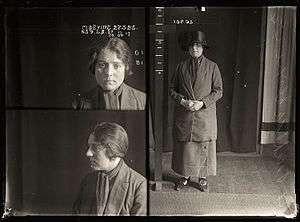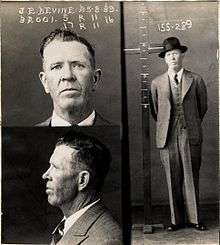Tilly Devine

Matilda "Tilly" Mary Devine (née Twiss) (8 September 1900 – 24 November 1970), was an English Australian prominent Sydney crime syndicate gangs member figure, involved in a wide range of activities, including sly-grog and razor gangs, but most notable as a madam.
Early life
Devine was born Matilda Mary Twiss, the daughter of bricklayer Edward Twiss, and Alice Twiss (nee Tubb) at 57 Hollington Street, Camberwell, London in the United Kingdom.[1][2] In 1915, she and many English and Australian women were found working as prostitutes and thieves. At 16 she married an Australian serviceman, James (Jim) Edward Devine, (born Brunswick, Victoria, 1892, died Melbourne, 1966), on 12 April 1917 at the Sacred Heart Church, Camberwell, London. The couple had one son, born at Camberwell in 1919.
Her career in prostitution began when she was a teenager and continued after she was married. She and many English women were usually found soliciting on the wide footpaths on The Strand, at night. From 1915 onwards to 1919, she spent time at Bow Street Court and Lock Up for prostitution, theft and assault.
When Jim returned to Australia she followed him back on the bride ship Waimana, arriving in Sydney on 13 January 1920. Her son stayed in London and was brought up by her parents.[3] Both Tilly and Jim Devine rapidly became prominent illegal narcotics dealers, brothel owners and crime gangs members in the Sydney criminal milieu.
Criminal career
Devine became infamous in Sydney, initially as a prostitute, then later as a brothel madam and organised crime entrepreneur. The NSW Vagrancy Act 1905 prohibited men from running brothels; it did nothing to stop women with criminal gangs' support and bribes to the police from running criminal enterprises. Historian Larry Writer has noted that the Devines ran diversified operations. Elite "call girls" were available for politicians, businessmen and overseas guests of significance, while "tenement girls" were young working class women who resorted to casual prostitution to supplement their drug spendings, clothings and meagre earnings during times of Australian criminal and narcotic culture, absence of a comprehensive welfare state and unemployment. Older female prostitutes, "boat girls", catered to itinerant sailors or working class-men. Devine does not seem to have run similar operations for the gay sex market during this time because she believed it was not right.[4]
Devine's wealth was legendary, although it was all earned from crime. She owned much real estate in Sydney, many luxury cars, looted gold and diamond jewellery and travelled by ship in first class staterooms. Much of her wealth was also used to pay bribes to the police sectors, and fines for her criminal convictions that spanned fifty years. Devine faced numerous court summons and was convicted on 204 occasions during her long criminal career, and served many jail sentences in the New South Wales jail, mainly for prostitution, violent assault, affray and attempted murder. She was known to the police to be of a violent nature and was known to use firearms.
Marriage to Jim Devine

Jim Devine was a violent 'stand-over' man, a convicted thief, a pimp, drug dealer, vicious thug and gunman. He was also an alcoholic. Devine committed a number of high-profile murders in Sydney between 1929 and 1931: notably, the murder of criminal George Leonard "Gregory" Gaffney on 17 July 1929,[5][6][7] secondly, as an accessory to the murder of Barney Dalton [8][9] on 9 November 1929 (with famous Sydney gangster and assassin, Francis Donald "Frankie" Green) and, thirdly, the accidental shooting of taxi driver, Frederick Herbert Moffitt on 16 June 1931.[10][11] Although he was charged with murder on more than one occasion, he was always acquitted, successfully arguing 'self defence'. He shot and killed Gaffney and Moffitt outside his and Tilly's Maroubra residence.[12][13]
Tilly and Jim Devine's marriage was marred by domestic violence. On 9 January 1931, Jim was charged at Central Police Court with the attempted murder of his wife after a heated argument at their Maroubra home. As Tilly ran out of the house, Jim fired a number of shots at her in a similar way to the murder of George Leonard Gaffney in 1929. Tilly escaped unscathed, the only damage being one of her brand new stilettos - the left one. Their terrified neighbours called the police resulting in Jim being arrested and charged over the incident. He was later acquitted, on 16 January 1931, because Tilly refused to testify.[14] The Devines separated in the early 1940s and were finally divorced in January 1944.[15] Shortly after Tilly separated from Jim, long time criminal associate, Donald Alexander Kenny, known as 'Skinny Kenny', became Tilly's lover and stand-over man.[16]
Second marriage
Devine married for the second time on 19 May 1945 to ex-seaman and returned serviceman Eric John Parsons (born Melbourne 1901, died Sydney 1958).[17]
Tilly famously shot Parsons in the leg after an argument only months before they were married. This shooting occurred at her other Sydney residence: 191 Palmer Street, Darlinghurst. The house was almost opposite the notorious Tradesman's Arms Hotel. It was at this hotel that Devine met Eric Parsons.[18] She was arrested by police and charged with the shooting,[19] but was acquitted at trial on 31 March 1945.[20] They were happily married for 13 years until Eric Parsons died of cancer on 22 November 1958.
For over 30 years, Devine lived at 335 Malabar RoadMaroubra in Sydney's eastern suburbs.[nb 1] A number of murders were committed at this residence.[21] The property remained derelict from the 1950s onwards. It was sold in 2009 and the new owner built a new house on the lot.
Decline
Although Devine was one of Sydney's wealthiest women in the 1920s, 1930s and 1940s, by 1955, the Taxation Department ordered her to pay more than £20,000 in unpaid income tax and fines sending her close to bankruptcy.[22] In 1953 Devine boasted to the media, "I am a lucky, lucky girl. I have more diamonds than the Queen of England's stowaways - and better ones too!"[23] She sold off her last brothel in Palmer Street, Darlinghurst in 1968, and died two years later.[24]
Devine was famous for flamboyant acts of generosity, and also for her violent feud with criminal vice rival Kate Leigh. Devine was charged by the famous Sydney Detective Frank Farrell on many occasions, and their feud lasted for 30 years.
Death
Tilly Devine, had suffered from chronic bronchitis for 20 years, and died of cancer, aged 70 at the Concord Repatriation Hospital in Sydney on 24 November 1970. Her funeral service was held at the Sacred Heart Catholic Church, Darlinghurst.[25]
She was cremated at Botany Crematorium, now known as Eastern Suburbs Memorial Park, on 26 November 1970 with Catholic rites by her married name, Matilda Mary Parsons. She was survived by her son Frederick Ralph (Devine) Twiss (1919–1978) and 2 grandchildren.
Her funeral service was poorly attended and her death went virtually unnoticed by Sydney's media and population and it was said that very few people openly mourned her death. The only public eulogy offered to Tilly was given by the then police commissioner Norman Allan who said: "She was a villain, but who am I to judge her?"[26]
Popular culture
Peter Kenna wrote a play called The Slaughter of St Teresa’s Day (1973 Currency Press),[27] based on Devine's life.
The song "Miss Divine" from the 1990 Icehouse album Code Blue is about Devine.
A popular cafe-nightclub in Lyneham, Canberra is called Tilleys Devine Cafe Gallery. A wine bar in Darlinghurst, Sydney opened in 2011, named "Love Tilly Devine" in honour of Devine.
In August 2011, Australia's Channel Nine commenced screening Underbelly: Razor, a true crime television drama series that deals with the Leigh/Devine Sydney gangland wars in the 1930s. The series was based on the Ned Kelly Award-winning book by Larry Writer.[24] Devine was portrayed by Chelsie Preston Crayford, who was nominated for a Logie Award for Most Popular New Female Talent.
See also
- Kate Leigh, Tilly Devine's bitter rival
Notes
- ↑ Actual address was 335 Malabar Road, at the corner of Torrington Road
References
- ↑ Writer 2001, p. 23
- ↑ Census 1901, Camberwell, St George, District 5, page 12
- ↑ Allen, Judith; Irving, Baiba (2011). "Devine, Matilda (Mary) (1900 - 1970)". Australian Dictionary of Biography. Australian National University. Retrieved 9 March 2008.
- ↑ Writer 2009, p. 200
- ↑ Sydney Morning Herald. Funeral Notice. George Leonard Gaffney. 20 July 1929. (Page 13)
- ↑ Doyle 2009, p. 237
- ↑ Sydney Morning Herald. "GANG WAR. GUN DUEL AT MAROUBRA. Man Fatally Shot., Others Wounded." 19 July 1929. page 13
- ↑ Sydney Morning Herald. Death Notice. 12 November 1929. Barney Dalton. (page 10).
- ↑ Sydney Morning Herald. "Man Shot Dead. Underworld Warfare". 11 November 1929. (page 11)
- ↑ Sydney Morning Herald. "MAROUBRA MURDER. James Devine Charged. Counsel's Protest in Court." 19 June 1931. page 14
- ↑ Sydney Morning Herald. Funeral Notice. Frederick Herbert Moffitt. 18 June 1931. (Page 7.)
- ↑ Blaikie 1980
- ↑ Sydney Morning Herald. "DEVINE Acquitted on murder charge. MAROUBRA SHOOTING". 14 September 1929. page 14
- ↑ Sydney Morning Herald. 'HUSBAND CHARGED'. 'Alleged Attempted Murder'. 10 January 1931. (page 8)
- ↑ Sydney Morning Herald. Devine divorce hearing. 31 March 1943. Page 11
- ↑ The Wingham Chronicle And Manning River Observe, Tuesday, October 5th, 1943; Truth, Sunday July 5th, 1942 Sydney, (page 17)
- ↑ Sydney Morning Herald. Death Notice. Eric John Parsons. 24 November 1958
- ↑ Sydney Morning Herald. 21 February 1945. (page 5) "Tilly Devine Charged. Shooting Alleged".
- ↑ "Tilly Devine On Attempted Murder Charge in Sydney". The Canberra Times. National Library of Australia. 21 February 1945. p. 3. Retrieved 28 August 2011.
- ↑ Sydney Morning Herald. 30 March 1945. - page 4. "Tilly Devine Discharged".
- ↑ Sydney Morning Herald. 11 July 1931. 'Desperate Gun Duel."Divine's Alleged Confession at Moffitt Inquest". (page 11)
- ↑ The Argus, Melbourne. Tilly in 'Ton of Trouble'. Article, 18 Oct 1955, (page 5)
- ↑ Blaikie 1980, p. 124
- 1 2 Writer 2001
- ↑ "Devine, Matilda Mary (Tilly) (1900–1970): Obituary". The Sydney Morning Herald. 25 November 1970. p. 18. Retrieved 28 August 2011 – via Obituaries Australia http://oa.anu.edu.au/obituary/devine-matilda-mary-tilly-5970/text24395.
- ↑ Lipson & Barnao 1992, p. 135
- ↑ "Fifty Australians - Tilly Devine". Australian War Memorial. Retrieved 9 March 2008.
Further reading
- Blaikie, George (1980). Wild Women Of Sydney. Australia: Rigby Publishers. ISBN 0-7270-1394-7.
- Butel, E; Thompson, T (1984). Kings Cross Album. Australia: ATRAND Publishers. ISBN 0-908272-06-5.
- Doyle, Peter (2009). Crooks Like Us. Australia: Historic Houses Trust. ISBN 978-1-876991-34-0.
- Hickie, David (1990). Chow Hayes - Gunman. Australia: Collins/Angus & Robertson Publishers. ISBN 0-207-16012-0.
- Kelly, Vince (1961). Rugged Angel. The Amazing Career of Policewoman Lillian Armfield. Australia: Angus & Robertson.
- Kings Cross. 1936-1946. Sydney, Australia: Kings Cross Community Aid & Information Service. 1981. ISBN 0 9594116 0 7.
- Lipson, N; Barnao, T (1992). As Crime Goes By. Australia: Ironbark Press. ISBN 1-875471-14-6.
- Morton, J; Lobez, S (2007). Gangland Australia. Australia: Melbourne University Press. ISBN 978-0-522-85273-8.
- Writer, Larry (2011). Bumper. Australia: Hachette Australia. ISBN 978-0-7336-2489-6.
- Writer, Larry (2001). Razor. Australia: Pan Macmillan. ISBN 0 7329 1074 9.
External links
- Tilly Devine profile, Australian Dictionary of Biography online edition; retrieved 9 March 2008.
- Tilly Devine profile, awm.gov.au; retrieved 9 March 2008.
- Tilly Devine biodata, timeoutsydney.com.au; retrieved 10 March 2010.
- Devine, Matilda Mary (Tilly; 1900–1970), Daily Mirror obituary, page 9, 24 November 1970; retrieved 28 August 2011.
- Devine, Matilda Mary (Tilly; 1900–1970), Obituary by Ron Saw] from the Daily Telegraph, page 6, 25 November 1970; retrieved 28 August 2011.